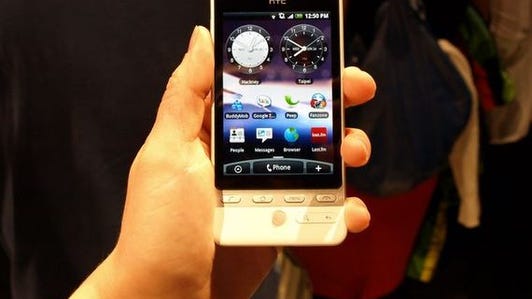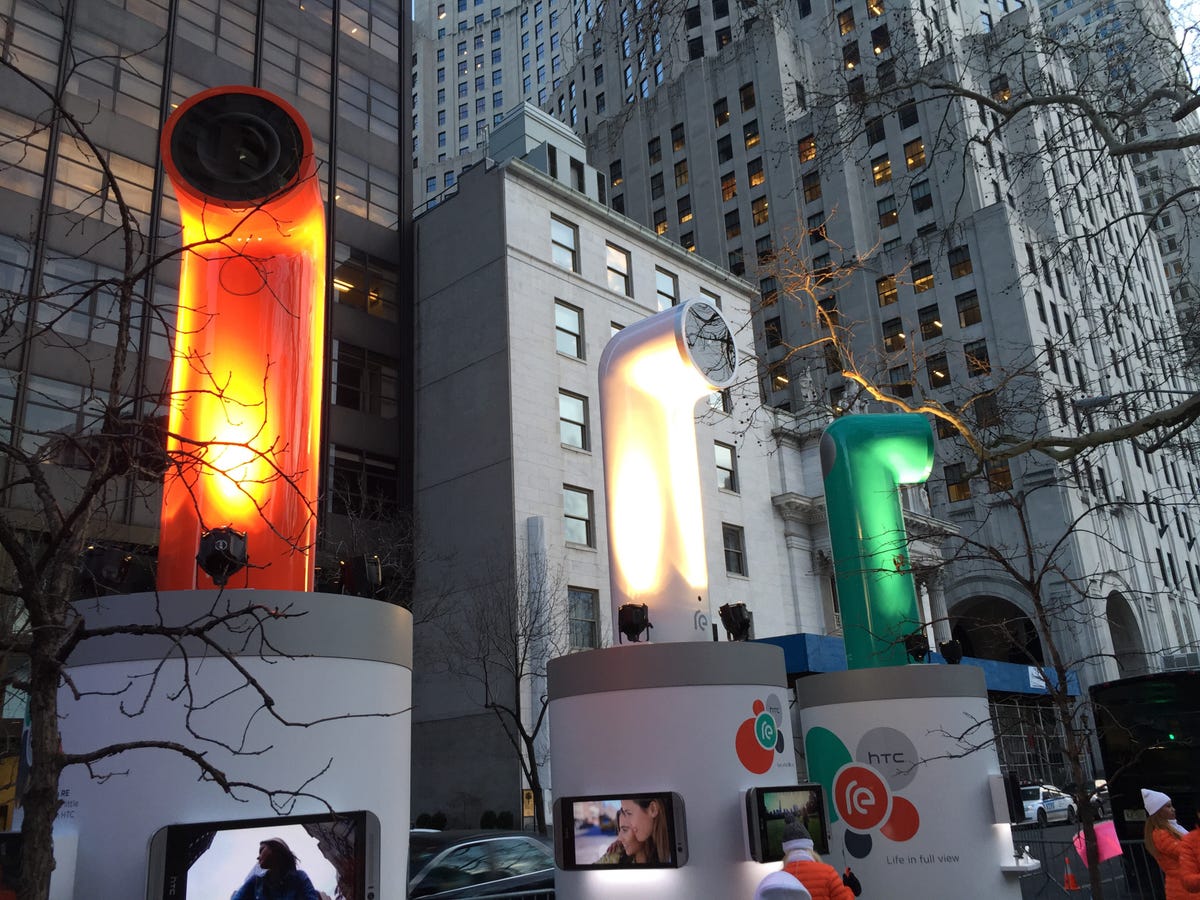
James Martin/CNET
SEATTLE–I arrived in the tech-revitalized, hipster neighborhood of Pioneer Square on a crisp December morning, eager to see HTC’s Creative Labs studio and meet up with the team of designers responsible for the novel interface software that fronts the Taiwanese-maker’s smartphones.
There was just one problem: I couldn’t find the place.
The typical sign with a corporate logo, emblazoned in bold letters, was nowhere to be found. There wasn’t even a tiny nameplate anywhere. After a careful search, I stood before a nondescript door that was sandwiched between an Italian restaurant and a hair salon. The shops, housed in a contemporary commercial brick building, both fit in with the colorful vibe of the area, but home to a branch of a global smartphone company?
“We don’t do much in the official way here,” said Drew Bamford, head of Creative Labs.
Its near-invisible profile in Pioneer Square seems fitting considering HTC’s history of crafting eye-catching metal-clad smartphones, like the HTC One M8 , only to have them ignored in favor of models from higher profile — and deeper pocketed — rivals Apple and Samsung Electronics. HTC’s inability to compete for attention against the bigger players, who spend billions of dollars each year on marketing versus HTC’s more modest budget, estimated to range in the tens or hundreds of millions, is the primary reason its profit has plunged 95 percent and its revenue has fallen by more than half over the last three years.
Related stories
- HTC’s next ‘One’ makes its debut: Join us March 1 (live blog)
- HTC: We’re not just about phones anymore
- The inside story of the HTC One M8
- How the HTC One M8 will put the pow in its pitch
- How HTC plans to sell the quirky, peculiar Re camera
In 2012, HTC, which generates nearly all of its revenue from smartphones, was the No. 4 smartphone maker in the world, according to researcher IDC. In 2014, it had dropped below Samsung, Apple, Xiaomi, Lenovo and LG, shunted into the “other” category of companies that don’t merit mention.
HTC is now ready to make noise and craft out a new identity for itself as a broader personal technology company. Its next leap? To expand beyond the comfort zone of the smartphone market, now dominated by Apple on one end and myriad competitors scrambling for budget-conscious consumers on the other end, by offering new gadgets in the areas of fitness, cameras and, potentially, gaming.
The transformation marks the next chapter for a 17-year-old underdog that built its business by anticipating and jumping on new trends like the emergence of Google’s Android software and new wireless technologies such as LTE.
“The (smartphone) market is slowing down,” said Ramon Llamas, an analyst for Framingham, Massachusetts-based IDC. “It’s becoming harder and harder to differentiate against the competition.”
That’s why CEO Peter Chou, with help from Bamford and his Seattle-based team, plan to use the Mobile World Congress trade show, which unofficially kicks off March 1 , as a coming out party for the new HTC. Yes, there will be the next version of its flagship HTC One smartphone.


Josh Miller/CNET
But just as important is its entry into the fitness tracker arena with a product created in partnership with Under Armour. HTC also plans to get to into the entertainment device market, with its sponsorship of a trio of competitive video game teams in January signaling a focus on gaming. That follows the November debut of the Re portable camera , its first non-traditional product.
On the software side, HTC turned its Zoe photo-video editor feature into a free app for all Android users, the first in a line of apps that the company plans to bring to all smartphone users, and not just HTC customers.
Together, the new offerings paint a picture of a company working to create a broader family of connected devices and apps with the help of partners. It won’t be easy, analysts say, noting that beyond the inherent risks of entering a new business, HTC’s lack of recognition makes it that much harder to get customers to notice. Results from a customer loyalty survey released last week by research consultancy Key Brands found the company’s name didn’t even register.
So the alternative is stay stagnant and risk irrelevancy — or die.
“HTC can’t afford not to do this,” Bamford said.
A creative ‘seed’
HTC’s headquarters are in Taiwan, but many of the hardware and software flourishes that help differentiate its products are dreamed up in satellite offices in the US.
Pioneer Square hosts Bamford and 35 members of his design team in a workspace befitting a team obsessed with aesthetics, although he plans to move his full team of 120 people into a nearby larger building in the spring.


James Martin/CNET
As I walked up the stairs to the airy second-floor open space — lit by morning light that floods in through oversized, half-moon windows — I noticed a long table, filled with two rows of mostly iMacs, on one side of the office. Next to one computer is a sign that reads: “3 things I love: sports, motorsports and making s— look pretty.” Hanging just behind the table and chairs is an equally long whiteboard filled with sketches, random notes and a quote from actor George Clooney: “You can be cautious or you can be creative. There is no such thing as a cautious creative.”
Bamford is alone in the office — his team won’t shuffle in for another hour or so. With matted down, curly brunette hair and glasses, the 42-year-old looks youthful and boyish in a color-coordinated outfit consisting of a black hoodie, v-neck T-shirt, pants and sneakers.
Creative Labs handles the software experience on HTC’s smartphone, including the overall Sense smartphone user interface that helped the company set itself apart from rivals in the early days of Android smartphones thanks to its trademark retro clock-and-weather-widget and easy-to-approach interface.
There’s also Blinkfeed — a Flipboard-like feed for news and social updates that was added to Sense two years ago — and the Zoe camera app, which mixes photos and music into short video clips.
Creative Labs is, in many ways, driving HTC’s transformation since most of the software experiences powering the new products, including the Re camera, come from Bamford’s teams. Part of his mandate is to meet with other teams in the company and steadily shift the way they think about how they operate.
“We decided we were tired of being disrupted from the outside in, so we decided to disrupt from the inside out,” Bamford said in an hour-long interview. “This is not an experiment, this is a tectonic shift in what’s going on with HTC, and Creative Labs is the seed.”
The bet is that it can make some of these features work not just on HTC’s devices, but other Android smartphones and Apple’s iPhone and iPad, which are powered by the iOS operating system software.


HTC
The first such app is Zoe, which started out as a simple feature on HTC’s phones. In October, it launched on the Google Play store and made available to all Android users for free. Zoe will be released on Apple’s App Store this quarter, with the ultimate hope that the social component and cross-platform accessibility will earn it a following akin to Snapchat, the photo instant messaging service that’s wildly popular with today’s teens. Bamford’s work on the Zoe app led to the formal creation of Creative Labs.
The team’s next project may be to open up Blinkfeed to non-HTC Android and Apple users, although it has given no timeframe.
“You have to be willing to invest in a portfolio of products and hope some of them hit,” Bamford said.
That’s a big hope. “Those types of services don’t do well when limited to a single device or platform, which is how [Zoe] started out,” said Avi Greengart, who covers consumer tech for research firm Current Analysis. “To succeed in those areas, you need viral growth.”


James Martin/CNET
There are at least two potential payoffs from the move into apps. Getting an app distributed on Google Play and through the App Store helps bring attention to the HTC brand, particularly if it is well received. And if just one takes off, HTC gets a new source of revenue.
Blinkfeed, for example, has 7 million users, according to Bamford. If HTC releases it widely and it expands the audience to 50 million users, HTC could start making money off of the app through promoted content or advertising.
HTC, he admits, is a long way from those lofty goals.
Entering its ‘third life’
HTC likes to say it is embarking on its “third life” as a consumer tech company. Its first incarnation was as a little-known computer maker — HTC was originally known as High-Tech Computer Corporation. It evolved into making smartphones for other companies to sell under their own brands, a practice known as “white labeling.”
Corinne Schulze/CBS Interactive
In its second life, HTC made a name for itself as a consumer smartphone brand. In 2008, it debuted the Touch Diamond smartphone, which sported a forerunner to its Sense user interface on top of the old, clunky Windows Mobile operating system. That was also the first time the company made any significant noise about itself.
Things were looking up when HTC leapt onto the public stage with its partnership with Google on Android. Looking back, it’s easy to forget the move was a huge risk. HTC’s entire business at the time relied on Microsoft and the Windows Mobile operating system software. When Google went shopping for a partner for the first Android-based device, it chose HTC to produce the G1 , which debuted in September 2008. T-Mobile, an underdog itself, provided wireless service.
HTC’s hits and misses in the Android smartphone era (pictures)






“I remember selling to AT&T and Verizon, and I got the stiff arm,” recalled Jason MacKenzie, president of HTC’s North America business when the company first began developing Android smartphones.
Consumers welcomed HTC’s Sense interface as a more consumer-friendly coat of paint over Android, which lacked refinement at the time. By 2010, HTC saw its smartphones sold by multiple US carriers, including the Verizon Incredible and Sprint Evo 4G . Overseas, its Desire line of smartphones was a certifiable hit. Its HTC Legend was the first to employ an aluminum body — two years before Apple did the same with the iPhone 5.
“Where there used to be nothing, now they’re a force to be reckoned with,” Lois Fagan, then Sprint’s product executive said when the Evo launched.


Josh Miller/CNET
But HTC spread itself too thin, creating a number of smartphones models that failed to connect with consumers. It made the first attempt at a Facebook-centric smartphone, the Chacha (known as the AT&T Status in the US), which featured a dedicated button at the bottom to connect to the social network. The Rhyme , a smartphone built for Verizon that targeted women, also flopped. In 2013, the First — a second attempt at a Facebook phone that was built in cooperation with Facebook itself — quickly ended up in the bargain bin.
These duds coincided with declining earnings results and forced soul-searching at the company. In addition to streamlining its product portfolio, HTC warmed up to the idea of moving into new areas.
Still, there are signs that its retooled lineup, which includes the premium HTC One M8 and the more affordable Desire-branded smartphones — which can be purchased for as little as $100 without a contract — has helped turn things around. In January, HTC posted its first year-over-year sales gain since 2011 and better-than-expected profit.
A history of partnerships
HTC doesn’t plan on changing on its own. Its partnership with Under Armour, best known as a sportswear maker, is a sign of things to come. “They’re used to collaborating and working on these optimized experiences,” said Robin Thurston, senior vice president of digital connected fitness at Under Armour. “I certainly have found their teams easy to work with.”


Roger Cheng/CNET
The company’s willingness to work with others is in part driven by necessity — HTC’s relative lack of financial and marketing resources is a disadvantage as it squares off against larger competitors. It’s also driven in part by a history of partnering with carriers to build smartphones and with software companies such as Google and Microsoft. Even its ill-fated alliance with Facebook was borne out of its tendency to collaborate.
“It’s an odd phenomenon that every time a major company wants to do something big in wireless, there’s one company they go to,” HTC’s MacKenzie said.


James Martin/CNET
It was HTC’s strong relationship with AT&T that convinced the carrier to sell the $199 Re camera in its stores across the US. “It was wildly innovative,” Jeff Bradley, head of devices for AT&T, said about his first reaction to Re prototype. “Good for you for trying to break the mold into what is a crowded and established space.”
He declined to say how the Re camera sales are going, saying only the product has more strategic goals than tactical ones. “We were excited to have something innovative in our stores that could capture the imagination of consumers,” Bradley said.
HTC plans to keep working on new products by taking a startup-like approach to the efforts. Its primary incubator for new ideas is the year-old Advanced Concepts team, led by Claude Zellweger in San Francisco. Zellweger and Chou created the group and made its sole responsibility to identify product opportunities with the potential to become sustainable businesses over the next three to five years.


HTC
“It’s important that we’re not a gadget factory — we don’t want to create products that are distractions,” Zellweger said.
Ideas that make it through the early vetting process move up to Connected Products, a group Chou personally oversees, and is tasked with bringing those ideas to market.
All of the products go through Bamford’s group: Creative Labs is tasked with creating the software experiences for the devices.
HTC is targeting four areas: the “connected life,” which includes imaging and the Re camera, the “connected self,” which includes health and wearable devices like a fitness band, “connected entertainment,” which suggests gaming in part, and the “connected home.”
“What our goal is with Connected Products, 12 months from now, when people think of HTC, they think of HTC as a company that makes great consumer products,” said Jeff Gattis, head of marketing for the Connected Products units.
HTC’s mission to be a broader player in the consumer market isn’t novel. In reality, it is playing catch-up to Samsung, LG, Sony and Apple, which all sell a broad array of products beyond the smartphone. Apple is about to release a smartwatch, while Samsung makes everything from televisions to appliances.
What’s unique is how HTC is looking to fill the gap.
“It makes sense to partner with big brands to ride that tidal wave into new areas,” said Jefferson Wang, who covers telecom for IBB Consulting.
Smartphone still king
While HTC celebrated a return to sales growth last quarter and can tout numerous design awards for its products, the fact is it still gets lost in the market conversation.
Apple’s iPhone franchise remains dominant, and Samsung is expected to add metal to its next Galaxy S phone, upping the quality of its products.
Beyond Apple and Samsung, HTC also has to contend with a surging LG, which has rapidly improved its own smartphone line-up, as well as hot players like China’s Xiaomi, the world’s most valuable startup. Lenovo added to its reach by acquiring Motorola, which built its brand around affordable, yet highly customizable smartphones like the Moto X and Moto G.


CNET
It’s unclear if a new flagship smartphone will do much to help HTC stand out from the pack or if all that work in Pioneer Square will really help push the new business to life.
So is this evolution a desperate move or next logical next step? For Current Analysis Greengart, “It’s a little of both.”
And that maybe why, even as he touted HTC’s new product ambitions, Bamford reiterated throughout out his talk that the company’s focus remains on its main moneymaker, the smartphone business. After all, he said, the smartphone business could keep driving the company if everything else fails.
It was late in the afternoon when I finished up my interviews. The designers were finishing up their take-out lunch together at the communal kitchen counter — a daily ritual for the team — when I walked down the stairs to leave. As the door closed behind me, it was Bamford’s last point that lingered in my mind.
“We recognize not all of them will be successful,” he said about HTC’s new ventures. “There’s a fair amount of chance that none of them will be successful. But we still need to try.”


Now playing:
Watch this:
What is Mobile World Congress?
1:36



